目录
在web.xml配置文件中核心控制器DispatcherServlet
2、使用ModelAndView向request域对象共享数据
一、SpringMVC简介
1、什么是MVC
MVC是一种软件架构的思想,将软件按照模型、视图、控制器来划分
M:Model,模型层,指工程中的JavaBean,作用是处理数据
JavaBean分为两类:
-
一类称为实体类Bean:专门存储业务数据的,如 Student、User 等
-
一类称为业务处理 Bean:指 Service 或 Dao 对象,专门用于处理业务逻辑和数据访问。
V:View,视图层,指工程中的html或jsp等页面,作用是与用户进行交互,展示数据
C:Controller,控制层,指工程中的servlet,作用是接收请求和响应浏览器
MVC的工作流程: 用户通过视图层发送请求到服务器,在服务器中请求被Controller接收,Controller调用相应的Model层处理请求,处理完毕将结果返回到Controller,Controller再根据请求处理的结果找到相应的View视图,渲染数据后最终响应给浏览器
2、什么是SpringMVC
SpringMVC是Spring的一个后续产品,是Spring的一个子项目
SpringMVC 是 Spring 为表述层开发提供的一整套完备的解决方案。在表述层框架历经 Strust、WebWork、Strust2 等诸多产品的历代更迭之后,目前业界普遍选择了 SpringMVC 作为 Java EE 项目表述层开发的首选方案。
注:三层架构分为表述层(或表示层)、业务逻辑层、数据访问层,表述层表示前台页面和后台servlet
3、SpringMVC的特点
-
Spring 家族原生产品,与 IOC 容器等基础设施无缝对接
-
基于原生的Servlet,通过了功能强大的前端控制器DispatcherServlet,对请求和响应进行统一处理
-
表述层各细分领域需要解决的问题全方位覆盖,提供全面解决方案
-
代码清新简洁,大幅度提升开发效率
-
内部组件化程度高,可插拔式组件即插即用,想要什么功能配置相应组件即可
-
性能卓著,尤其适合现代大型、超大型互联网项目要求
二、环境搭建
1.新建一个maven-webapp项目
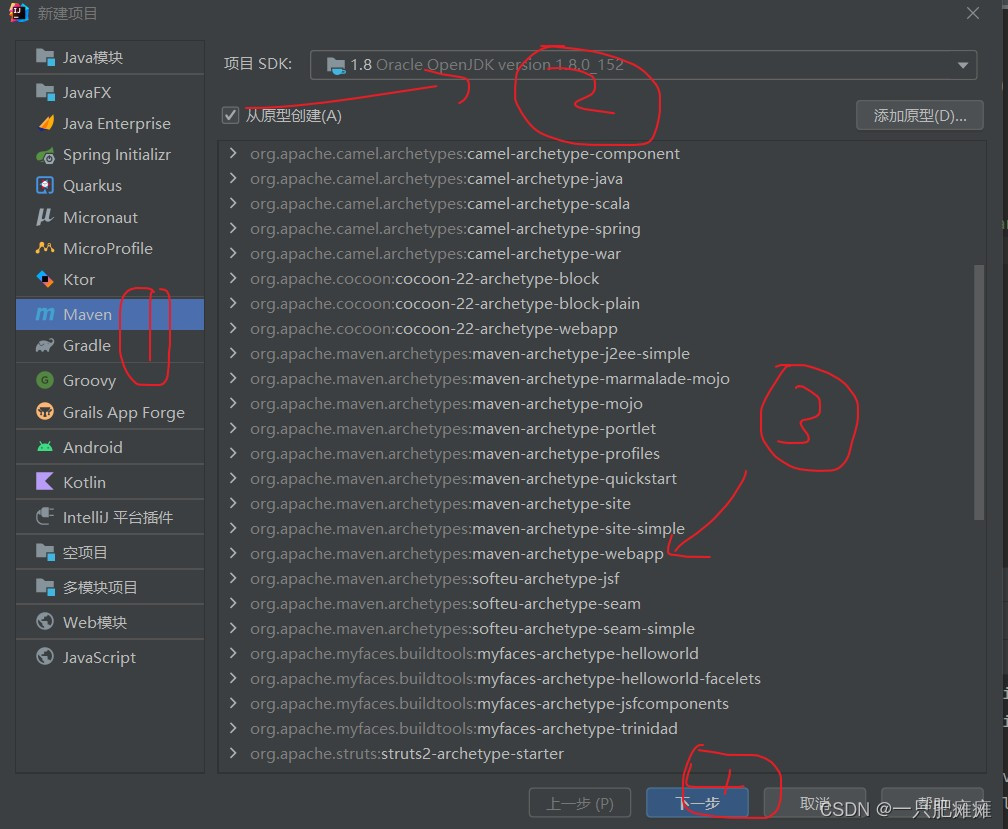
2.SpringMvc项目命名
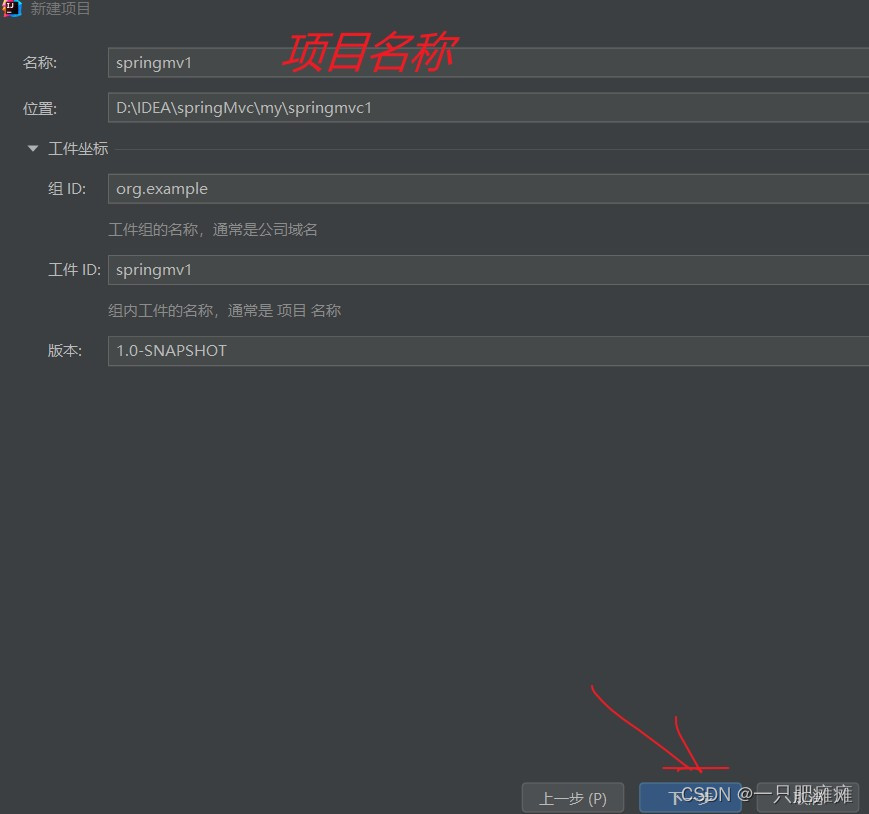
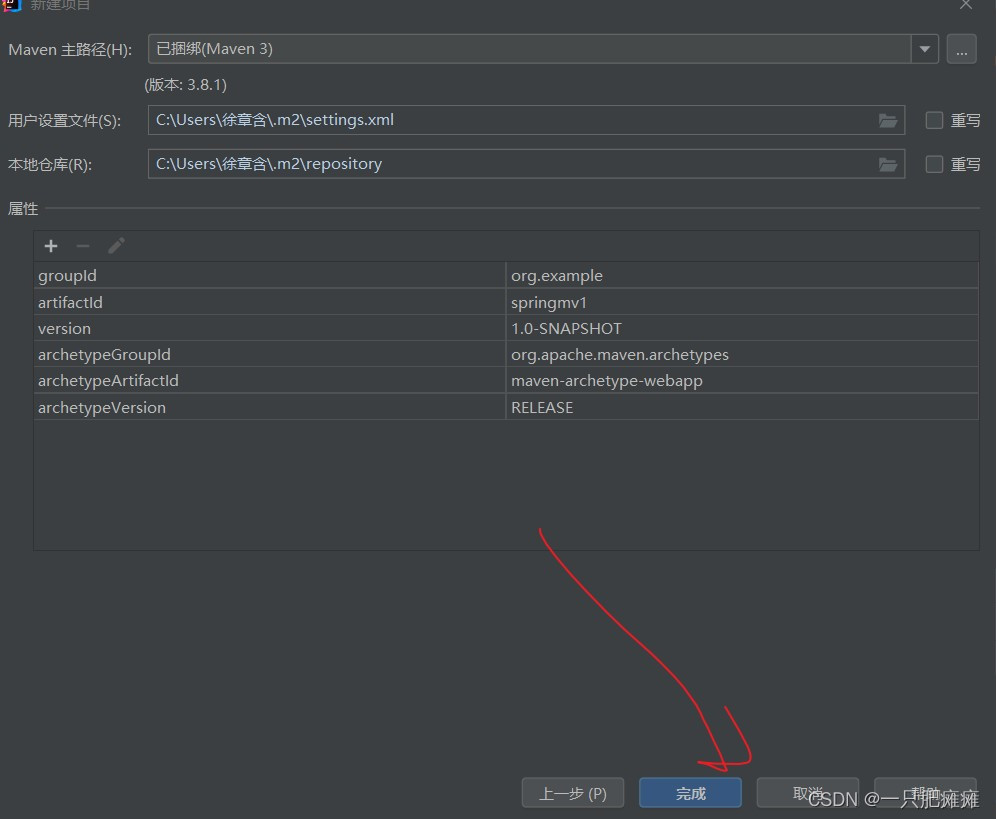
3.配置pom.xml文件
<dependencies>
<dependency>
<groupId>org.springframework</groupId>
<artifactId>spring-context</artifactId>
<version>5.3.20</version>
</dependency>
<dependency>
<groupId>org.springframework</groupId>
<artifactId>spring-web</artifactId>
<version>5.3.19</version>
</dependency>
<!--SpringMVC-->
<dependency>
<groupId>org.springframework</groupId>
<artifactId>spring-webmvc</artifactId>
<version>5.3.19</version>
</dependency>
<!--servlet API-->
<dependency>
<groupId>javax.servlet</groupId>
<artifactId>servlet-api</artifactId>
<version>2.5</version>
<scope>provided</scope>
</dependency>
<dependency>
<groupId>javax.servlet.jsp</groupId>
<artifactId>jsp-api</artifactId>
<version>2.0</version>
<scope>provided</scope>
</dependency>
<!--日志-->
<dependency>
<groupId>ch.qos.logback</groupId>
<artifactId>logback-classic</artifactId>
<version>1.2.3</version>
</dependency>
<dependency>
<groupId>org.thymeleaf</groupId>
<artifactId>thymeleaf-spring5</artifactId>
<version>3.1.0.M1</version>
</dependency>
</dependencies>
4.修改web.xml文件
<web-app version="3.0" xmlns="http://java.sun.com/xml/ns/javaee"
xmlns:xsi="http://www.w3.org/2001/XMLSchema-instance"
xsi:schemaLocation="http://java.sun.com/xml/ns/javaee
http://java.sun.com/xml/ns/javaee/web-app_3_0.xsd">
</web-app>
5.配置DispatcheServlet
Spring MVC是基于原生的servlet,通过强大的前端控制器DispatcheServlet,对请求和响应进行统一处理。
Spring MVC的本质就是一个servlet,是对原生的servlet进行了封装。在以前我们浏览器的每一次请求都需要我们写一个对应的servlet,现在我们只需要将浏览器的请求和响应交给DispatcheServlet进行统一的处理。
在web.xml配置文件中核心控制器DispatcherServlet
<!--在web.xml中配置Spring提供的过滤器类 -->
<filter>
<filter-name>encodingFilter</filter-name>
<filter-class>org.springframework.web.filter.CharacterEncodingFilter</filter-class>
<async-supported>true</async-supported>
<init-param>
<param-name>encoding</param-name>
<param-value>UTF-8</param-value>
</init-param>
</filter>
<filter-mapping>
<filter-name>encodingFilter</filter-name>
<url-pattern>/*</url-pattern>
</filter-mapping>
<!--不拦截所有是html的页面请求-->
<servlet-mapping>
<servlet-name>default</servlet-name>
<url-pattern>*.html</url-pattern>
</servlet-mapping>
<!--配置前端控制器,对浏览器发送的请求进行统一处理-->
<servlet>
<servlet-name>dispatcherServlet</servlet-name>
<servlet-class>org.springframework.web.servlet.DispatcherServlet</servlet-class>
<!--加载springmvc.xml配置文件的位置和名称,配置的是Spring配置-->
<init-param>
<!--contextConfigLocation:上下文配置路径,固定值-->
<param-name>contextConfigLocation</param-name>
<!--classpath:类路径,值得是Java和resources文件夹-->
<!--springmvc.xml:指的是配置文件的名称:需要配置springmvc.xml,在下面-->
<param-value>classpath:springmvc.xml</param-value>
</init-param>
<!--配置启动加载-->
<load-on-startup>1</load-on-startup>
</servlet>
<servlet-mapping>
<servlet-name>dispatcherServlet</servlet-name>
<url-pattern>/</url-pattern>
</servlet-mapping>
<!--开启项目时打开的页面,此处指根目录下的index.html页面-->
<welcome-file-list>
<welcome-file>/index.html</welcome-file>
</welcome-file-list>
6.配置index.html文件和suc.html文件

index.html
<html>
<head>
<meta charset="utf-8">
<title>入门程序</title>
</head>
<body>
<h3>入门</h3><a href="/SpringMvcTest/hello" >入门程序</a>
</body>
</html>suc.html:
<html lang="en" xmlns:th="http://www.thymeleaf.org">
<head>
<meta charset="UTF-8">
<title>成功</title>
</head>
<body>
<h1>Hello <b th:text="${msg}"></b></h1>
喜洋洋
</body>
<script>
</script>
</html>7.配置Controller类和方法
package com.qcby.controller;
import org.springframework.stereotype.Controller;
import org.springframework.ui.Model;
import org.springframework.web.bind.annotation.RequestMapping;
//把当前类交给IOC容器进行管理
@Controller
public class HelloController {
/**
* 处理超链接发送出来的请求
* @param model
* @return
*/
@RequestMapping(path = "/hello")
public String sayHello(Model model){
System.out.println("入门方法执行了2...");
// 向模型中添加属性msg与值,可以在html页面中取出并渲染
model.addAttribute("msg","hello,SpringMVC");
// 配置了视图解析器后,写法
return "suc";
}
}8.编写springmvc.xml的配置文件
<?xml version="1.0" encoding="UTF-8"?>
<beans xmlns="http://www.springframework.org/schema/beans"
xmlns:xsi="http://www.w3.org/2001/XMLSchema-instance"
xmlns:context="http://www.springframework.org/schema/context"
xmlns:mvc="http://www.springframework.org/schema/mvc"
xsi:schemaLocation="http://www.springframework.org/schema/beans
http://www.springframework.org/schema/beans/spring-beans.xsd
http://www.springframework.org/schema/context
http://www.springframework.org/schema/context/spring-context.xsd
http://www.springframework.org/schema/mvc
http://www.springframework.org/schema/mvc/spring-mvc.xsd">
<!--配置spring创建容器时要扫描的包-->
<context:component-scan base-package="com.qcby"></context:component-scan>
<!--处理映射器-->
<bean class="org.springframework.web.servlet.handler.BeanNameUrlHandlerMapping"/>
<!--处理器适配器-->
<bean class="org.springframework.web.servlet.mvc.SimpleControllerHandlerAdapter"/>
<!--配置视图解析器-->
<bean id="viewResolver" class="org.thymeleaf.spring4.view.ThymeleafViewResolver">
<property name="order" value="1"/>
<property name="characterEncoding" value="UTF-8"/>
<property name="templateEngine" ref="templateEngine"/>
</bean>
<!-- templateEngine -->
<bean id="templateEngine" class="org.thymeleaf.spring4.SpringTemplateEngine">
<property name="templateResolver" ref="templateResolver"/>
</bean>
<bean id="templateResolver" class="org.thymeleaf.spring4.templateresolver.SpringResourceTemplateResolver">
<property name="prefix" value="/html/" />
<property name="suffix" value=".html" />
<property name="templateMode" value="HTML5"/>
</bean>
<!--配置spring开启注解mvc的支持 默认就是开启的 ,要想让其他组件(不包含映射器、适配器、处理器)生效就必须需要配置了-->
<mvc:annotation-driven></mvc:annotation-driven>
</beans>9.启动Tomcat服务器,运行成功
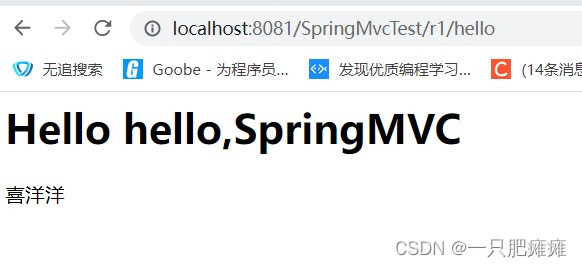
三、@RequestMapping注解
1、@RequestMapping注解的功能
从注解名称上我们可以看到,@RequestMapping注解的作用就是将请求和处理请求的控制器方法关联起来,建立映射关系。SpringMVC 接收到指定的请求,就会来找到在映射关系中对应的控制器方法来处理这个请求。
2、@RequestMapping注解的位置
@RequestMapping标识一个类:设置映射请求的请求路径的初始信息
@RequestMapping标识一个方法:设置映射请求请求路径的具体信息
@RequestMapping("/RequestMapping")
public String test(){
return "RequestMapping";
}3、@RequestMapping注解的value属性
@RequestMapping注解的value属性通过请求的请求地址匹配请求映射
@RequestMapping注解的value属性是一个字符串类型的数组,表示该请求映射能够匹配多个请求地址所对应的请求
@RequestMapping注解的value属性必须设置,至少通过请求地址匹配请求映射
<form action="/SpringMvcTest/r1/testParam" method="post">
用户名:<input type="text" name="name">
密码:<input type="password" name="password">
爱好:<input type="checkbox" name="hobby" value="a">a
<input type="checkbox" name="hobby" value="b">b
<input type="checkbox" name="hobby" value="c">c
<input type="submit" value="通过控制器方法的形参获取请求参数">
</form> @RequestMapping("/testParam")
public String testParam(String name, String password,String[] hobby){
System.out.println("name:"+name+",password:"+password+",hobby+"+ Arrays.toString(hobby));
return "RequestMapping";
}4、@RequestMapping注解的method属性
@RequestMapping注解的method属性通过请求的请求方式(get或post)匹配请求映射@RequestMapping注解的method属性是一个RequestMethod类型的数组,表示该请求映射能够匹配多种请求方式的请求若当前请求的请求地址满足请求映射的value属性,但是请求方式不满足method属性,则浏览器报错405:Request method 'POST' not supported
<a th:href="@{/test}">测试@RequestMapping的value属性-->/test</a><br>
<form th:action="@{/test}" method="post">
<input type="submit">
</form>@RequestMapping(
value = {"/testRequestMapping", "/test"},
method = {RequestMethod.GET, RequestMethod.POST}
)
public String testRequestMapping(){
return "success";
}注:
1、对于处理指定请求方式的控制器方法,SpringMVC中提供了@RequestMapping的派生注解
处理get请求的映射-->@GetMapping
处理post请求的映射-->@PostMapping
处理put请求的映射-->@PutMapping
处理delete请求的映射-->@DeleteMapping
2、常用的请求方式有get,post,put,delete
但是目前浏览器只支持get和post,若在form表单提交时,为method设置了其他请求方式的字(put或delete),则按照默认的请求方式get处理。
5、@RequestMapping注解的params属性
@RequestMapping注解的params属性通过请求的请求参数匹配请求映射
@RequestMapping注解的params属性是一个字符串类型的数组, 可以通过四种表达式设置请求参数和请求映射的匹配关系
"param":要求请求映射所匹配的请求必须携带param请求参数
"!param":要求请求映射所匹配的请求必须不能携带param请求参数
"param=value":要求请求映射所匹配的请求必须携带param请求参数且param=value
"param!=value":要求请求映射所匹配的请求必须携带param请求参数但是param!=value
<a href="/test?username='admin'&password=123456">测试@RequestMapping的params属性-->/test</a><br>@RequestMapping(
value = {"/testRequestMapping", "/test"}
,method = {RequestMethod.GET, RequestMethod.POST}
,params = {"username","password!=123456"}
)
public String testRequestMapping(){
return "success";
}
6、SpringMVC支持路径中的占位符
原始方式:/deleteUser?id=1
rest方式:/deleteUser/1
SpringMVC路径中的占位符常用于RESTful风格中,当请求路径中将某些数据通过路径的方式传输到服务器中,就可以在相应的@RequestMapping注解的value属性中通过占位符{xxx}表示传输的数据,在通过@PathVariable注解,将占位符所表示的数据赋值给控制器方法的形参
<a href="/testRest/1/admin">测试路径中的占位符-->/testRest</a><br>@RequestMapping("/testRest/{id}/{username}")
public String testRest(@PathVariable("id") String id, @PathVariable("username") String username){
System.out.println("id:"+id+",username:"+username);
return "success";
}
//最终输出的内容为-->id:1,username:admin四、SpringMVC获取请求参数
1、通过ServletAPI获取
将HttpServletRequest作为控制器方法的形参,此时HttpServletRequest类型的参数表示封装了当前请求的请求报文的对象
@RequestMapping("/testParam")
public String testParam(HttpServletRequest request){
String username = request.getParameter("username");
String password = request.getParameter("password");
System.out.println("username:"+username+",password:"+password);
return "success";
}2、通过控制器方法的形参获取请求参数
在控制器方法的形参位置,设置和请求参数同名的形参,当浏览器发送请求,匹配到请求映射时,在DispatcherServlet中就会将请求参数赋值给相应的形参
<a th:href="/testParam?username='admin'&password=123456">测试获取请求参数-->/testParam</a><br>@RequestMapping("/testParam")
public String testParam(String username, String password){
System.out.println("username:"+username+",password:"+password);
return "success";
}注:
若请求所传输的请求参数中有多个同名的请求参数,此时可以在控制器方法的形参中设置字符串数组或者字符串类型的形参接收此请求参数
若使用字符串数组类型的形参,此参数的数组中包含了每一个数据
若使用字符串类型的形参,此参数的值为每个数据中间使用逗号拼接的结果
<form action="testParam" method="post">
用户名:<input type="text" name="name">
密码:<input type="password" name="password">
爱好:<input type="checkbox" name="hobby" value="a">a
<input type="checkbox" name="hobby" value="b">b
<input type="checkbox" name="hobby" value="c">c
<input type="submit" value="通过控制器方法的形参获取请求参数">
</form>@RequestMapping("/testParam")
public String testParam(String name, String password,String[] hobby){
System.out.println("name:"+name+",password:"+password+",hobby+"+ Arrays.toString(hobby));
return "param";
}3、@RequestParam
a->作用:
@RequestParam:将请求参数绑定到你控制器的方法参数上(是springmvc中接收普通参数的注解)
b->语法:
语法:@RequestParam(value=”参数名”,required=”true/false”,defaultValue=””)
value:参数名
required:是否包含该参数,默认为true,表示该请求路径中必须包含该参数,如果不包含就报错。
defaultValue:默认参数值,如果设置了该值,required=true将失效,自动为false,如果没有传该参数,就使用默认值
c->业务处理
@Controller
@RequestMapping("hello")
public class HelloController2 {
@RequestMapping("show16")
public ModelAndView test16(@RequestParam("name")String name){
ModelAndView mv = new ModelAndView();
mv.setViewName("hello2");
mv.addObject("msg", "接收普通的请求参数:" + name);
return mv;
}
@RequestMapping("show17")
public ModelAndView test17(@RequestParam(value="name",required=false)String name){
ModelAndView mv = new ModelAndView();
mv.setViewName("hello2");
mv.addObject("msg", "接收普通请求参数:" + name);
return mv;
}
@RequestMapping("show18")
public ModelAndView test18(@RequestParam(value="name",required=true,defaultValue="hello")String name){
ModelAndView mv = new ModelAndView();
mv.setViewName("hello2");
mv.addObject("msg", "接收普通请求参数:" + name);
return mv;
}
}4、@RequestHeader
@RequestHeader是将请求头信息和控制器方法的形参创建映射关系
@RequestHeader注解一共有三个属性:value、required、defaultValue,用法同@RequestParam
<a href="/SpringMvcTest/r1/requestHeaderTest">测试@RequestHeader注解</a> @RequestMapping("/requestHeaderTest")
public String aa(@RequestHeader("User-Agent") String userAgent,
@RequestHeader(value="Accept") String[] accepts){
System.out.println("通过@requestHeaderTest获得User-Agent: " + userAgent);
System.out.println("通过@requestHeaderTest获得Accept: ");
// 循环输出头信息
for(String accept : accepts){
System.out.println(accept);
}
return "RequestMapping";
}5、通过POJO获取请求参数
可以在控制器方法的形参位置设置一个实体类类型的形参,此时若浏览器传输的请求参数的参数名和实体类中的属性名一致,那么请求参数就会为此属性赋值
public class User {
private Integer id;
private String username;
private String password;
private String sex;
private Integer age;
private String email;
public Integer getId() {
return id;
}
public void setId(Integer id) {
this.id = id;
}
public String getUsername() {
return username;
}
public void setUsername(String username) {
this.username = username;
}
public String getPassword() {
return password;
}
public void setPassword(String password) {
this.password = password;
}
public String getSex() {
return sex;
}
public void setSex(String sex) {
this.sex = sex;
}
public Integer getAge() {
return age;
}
public void setAge(Integer age) {
this.age = age;
}
public String getEmail() {
return email;
}
public void setEmail(String email) {
this.email = email;
}
@Override
public String toString() {
return "User{" +
"id=" + id +
", username='" + username + '\'' +
", password='" + password + '\'' +
", sex='" + sex + '\'' +
", age=" + age +
", email='" + email + '\'' +
'}';
}
}
<form action="/SpringMvcTest/r1/testpojo" method="post">
用户名:<input type="text" name="username"><br>
密码:<input type="password" name="password"><br>
性别:<input type="radio" name="sex" value="男">男<input type="radio" name="sex" value="女">女<br>
年龄:<input type="text" name="age"><br>
邮箱:<input type="text" name="email"><br>
<input type="submit">
</form> @RequestMapping("/testpojo")
public String testPOJO(User user){
System.out.println(user);
return "RequestMapping";
}
五、域对象共享数据
1、使用ServletAPI向request域对象共享数据
//使用servletAPI向request域对象共享数据
@RequestMapping("/servletAPI")
public String servletAPI(HttpServletRequest request){
request.setAttribute("testRequestScope","hello,servletAPI");
return "success";
}<a th:href="@{/servletAPI}">使用servletAPI向request域对象共享数据</a><br/>2、使用ModelAndView向request域对象共享数据
//使用ModelAndView向request域对象共享数据
@RequestMapping("/modelAndView")
public ModelAndView modelAndView(){
/*
ModelAndView有Model和View的功能
Model主要用于向请求域共享数据
View主要用于设置视图,实现页面跳转
*/
ModelAndView mav = new ModelAndView();
//向请求域共享数据
mav.addObject("testRequestScope","hello,modelAndView");
//设置视图,实现页面跳转
mav.setViewName("success");
return mav;
}<a th:href="@{/modelAndView}">使用ModelAndView向request域对象共享数据</a><br/>3.使用Model向request域对象共享数据
@RequestMapping("/testModel")
public String testModel(Model model){
model.addAttribute("testScope", "hello,Model");
return "success";
}4、使用map向request域对象共享数据
@RequestMapping("/testMap")
public String testMap(Map<String, Object> map){
map.put("testScope", "hello,Map");
return "success";
}5、使用ModelMap向request域对象共享数据
@RequestMapping("/testModelMap")
public String testModelMap(ModelMap modelMap){
modelMap.addAttribute("testScope", "hello,ModelMap");
return "success";
}6、向session域共享数据
@RequestMapping("/testSession")
public String testSession(HttpSession session){
session.setAttribute("testSessionScope", "hello,session");
return "success";
}7、向application域共享数据
@RequestMapping("/testApplication")
public String testApplication(HttpSession session){
ServletContext application = session.getServletContext();
application.setAttribute("testApplicationScope", "hello,application");
return "success";
}六、HttpMessageConverter
HttpMessageConverter,报文信息转换器,将请求报文转换为Java对象,或将Java对象转换为响应报文
HttpMessageConverter提供了两个注解和两个类型:@RequestBody,@ResponseBody,RequestEntity,ResponseEntity
1、@RequestBody
@RequestBody可以获取请求体,需要在控制器方法设置一个形参,使用@RequestBody进行标识,当前请求的请求体就会为当前注解所标识的形参赋值
<form th:action="@{/testRequestBody}" method="post">
用户名:<input type="text" name="username"><br>
密码:<input type="password" name="password"><br>
<input type="submit">
</form>@RequestMapping("/testRequestBody")
public String testRequestBody(@RequestBody String requestBody){
System.out.println("requestBody:"+requestBody);
return "success";
}2、RequestEntity
RequestEntity封装请求报文的一种类型,需要在控制器方法的形参中设置该类型的形参,当前请求的请求报文就会赋值给该形参,可以通过getHeaders()获取请求头信息,通过getBody()获取请求体信息
@RequestMapping("/testRequestEntity")
public String testRequestEntity(RequestEntity<String> requestEntity){
System.out.println("requestHeader:"+requestEntity.getHeaders());
System.out.println("requestBody:"+requestEntity.getBody());
return "success";
}
3、@ResponseBody
@ResponseBody用于标识一个控制器方法,可以将该方法的返回值直接作为响应报文的响应体响应到浏览器
@RequestMapping("/testResponseBody")
@ResponseBody
public String testResponseBody(){
return "success";
}4、SpringMVC处理json
@ResponseBody处理json的步骤:
a>导入jackson的依赖
<dependency>
<groupId>com.fasterxml.jackson.core</groupId>
<artifactId>jackson-databind</artifactId>
<version>2.12.1</version>
</dependency>b>在SpringMVC的核心配置文件中开启mvc的注解驱动,此时在HandlerAdaptor中会自动装配一个消息转换器:MappingJackson2HttpMessageConverter,可以将响应到浏览器的Java对象转换为Json格式的字符串
<mvc:annotation-driven></mvc:annotation-driven>c>在处理器方法上使用@ResponseBody注解进行标识
d>将Java对象直接作为控制器方法的返回值返回,就会自动转换为Json格式的字符串
@RequestMapping("/testResponseUser")
@ResponseBody
public User testResponseUser(){
return new User(1001,"admin","123456",23,"男");
}浏览器的页面中展示的结果:
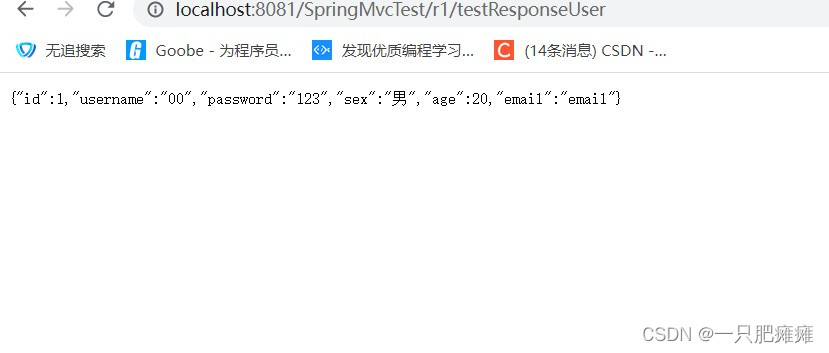
5、SpringMVC处理ajax
a>请求超链接:
<div id="app">
<a th:href="@{/testAjax}" @click="testAjax">testAjax</a><br>
</div>b>通过vue和axios处理点击事件:
<script type="text/javascript" th:src="@{/static/js/vue.js}"></script>
<script type="text/javascript" th:src="@{/static/js/axios.min.js}"></script>
<script type="text/javascript">
var vue = new Vue({
el:"#app",
methods:{
testAjax:function (event) {
axios({
method:"post",
url:event.target.href,
params:{
username:"admin",
password:"123456"
}
}).then(function (response) {
alert(response.data);
});
event.preventDefault();
}
}
});
</script>c>控制器方法:
@RequestMapping("/testAjax")
@ResponseBody
public String testAjax(String username, String password){
System.out.println("username:"+username+",password:"+password);
return "hello,ajax";
}6、@RestController注解
@RestController注解是springMVC提供的一个复合注解,标识在控制器的类上,就相当于为类添加了@Controller注解,并且为其中的每个方法添加了@ResponseBody注解
7、ResponseEntity
ResponseEntity用于控制器方法的返回值类型,该控制器方法的返回值就是响应到浏览器的响应报文
七、拦截器
1、拦截器的配置
SpringMVC中的拦截器用于拦截控制器方法的执行
SpringMVC中的拦截器需要实现HandlerInterceptor
SpringMVC的拦截器必须在SpringMVC的配置文件中进行配置:
<!-- 配置拦截器 -->
<mvc:interceptors>
<mvc:interceptor>
<!-- 用于指定拦截的 url -->
<mvc:mapping path="/**"/>
<!-- 用于指定排除的 url-->
<mvc:exclude-mapping path="/login/**"/>
<bean id="handlerInterceptorDemo" class="com.test.controller.HandlerInterceptorDemo"></bean>
</mvc:interceptor>
</mvc:interceptors>2、拦截器的三个抽象方法
SpringMVC中的拦截器有三个抽象方法:
preHandle:控制器方法执行之前执行preHandle(),其boolean类型的返回值表示是否拦截或放行,返回true为放行,即调用控制器方法;返回false表示拦截,即不调用控制器方法
postHandle:控制器方法执行之后执行postHandle()
afterComplation:处理完视图和模型数据,渲染视图完毕之后执行afterComplation()
3、多个拦截器的执行顺序
a>若每个拦截器的preHandle()都返回true
此时多个拦截器的执行顺序和拦截器在SpringMVC的配置文件的配置顺序有关:
preHandle()会按照配置的顺序执行,而postHandle()和afterComplation()会按照配置的反序执行
b>若某个拦截器的preHandle()返回了false
preHandle()返回false和它之前的拦截器的preHandle()都会执行,postHandle()都不执行,返回false的拦截器之前的拦截器的afterComplation()会执行
public class FirstInterceptor implements HandlerInterceptor {
@Override
public boolean preHandle(HttpServletRequest httpServletRequest, HttpServletResponse httpServletResponse, Object o) throws Exception {
System.out.println("preHandle 拦截器拦截了");
return false;
}
@Override
public void postHandle(HttpServletRequest httpServletRequest, HttpServletResponse httpServletResponse, Object o, ModelAndView modelAndView) throws Exception {
System.out.println("postHandle 方法执行了");
}
@Override
public void afterCompletion(HttpServletRequest httpServletRequest, HttpServletResponse httpServletResponse, Object o, Exception e) throws Exception {
System.out.println("afterCompletion 方法执行了");
}
}<a href="/SpringMvcTest/r1/abc">拦截器</a> @RequestMapping("/abc")
public String abc(){
return "data";
}
八、异常处理器
1、基于配置的异常处理
SpringMVC提供了一个处理控制器方法执行过程中所出现的异常的接口:HandlerExceptionResolver
HandlerExceptionResolver接口的实现类有:DefaultHandlerExceptionResolver和SimpleMappingExceptionResolver
SpringMVC提供了自定义的异常处理器SimpleMappingExceptionResolver,使用方式:
<bean class="org.springframework.web.servlet.handler.SimpleMappingExceptionResolver">
<property name="exceptionMappings">
<props>
<!--
properties的键表示处理器方法执行过程中出现的异常
properties的值表示若出现指定异常时,设置一个新的视图名称,跳转到指定页面
-->
<prop key="java.lang.ArithmeticException">error</prop>
</props>
</property>
<!--
exceptionAttribute属性设置一个属性名,将出现的异常信息在请求域中进行共享
-->
<property name="exceptionAttribute" value="ex"></property>
</bean><a href="/SpringMvcTest/r1/yccl">异常处理</a><br> @RequestMapping("/yccl")
public String yccl(){
System.out.println(1/0);
return "data";
}2、基于注解的异常处理
//@ControllerAdvice将当前类标识为异常处理的组件
@ControllerAdvice
public class ExceptionController {
//@ExceptionHandler用于设置所标识方法处理的异常
@ExceptionHandler(ArithmeticException.class)
//ex表示当前请求处理中出现的异常对象
public String handleArithmeticException(Exception ex, Model model){
model.addAttribute("ex", ex);
return "error";
}
}






















 152
152











 被折叠的 条评论
为什么被折叠?
被折叠的 条评论
为什么被折叠?








